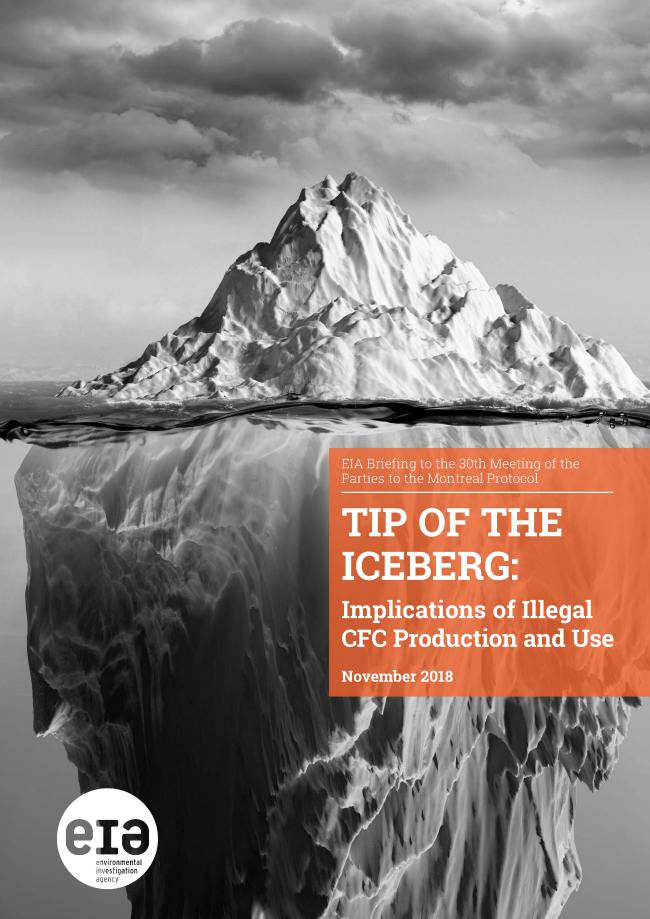05 November 2018
|
| The Environmental Investigation Agency (EIA) has released an update on China's illegal CFC-11 emissions crisis. In the new report published to coincide with the 30th Montreal Protocol meeting in Ecuador, the EIA also called for a global ban on the use of disposable, non-refillable refrigerant cylinders, which are being used widely in the illegal HFC refrigerant trade across Europe. |
Tip of the Iceberg: Implications of Illegal CFC Production and Use includes independent laboratory tests of polyurethane (PU) foam samples – provided by Chinese enterprises previously investigated by EIA – that confirm the presence of CFC-11 as a blowing agent.
Clare Perry, EIA UK Climate Campaigns Leader, said: “The scale and impact of this illegal trade shows how the Montreal Protocol’s current compliance and enforcement regime is not fit for purpose.
“With the Kigali Amendment coming into effect in 2019 and bringing with it additional challenges for enforcement, the need for decisive action is particularly urgent.
There has never been a greater need to make all possible reductions to greenhouse gas emissions in the fight against climate change; the steps the Protocol takes now will either make or break its reputation as the most successful environmental treaty ever.”
The EIA is urging Parties to the Montreal Protocol to address a number of remaining unanswered questions, in particular the absence of comprehensive data regarding the size of current banks of CFC-11 in PU foam and other products or equipment.
Avipsa Mahapatra, EIA US Climate Campaign Lead, said: “The new lab test results corroborate the veracity of statements made by these companies about using and trading in CFC-11 blowing agents. One of the companies claimed to be the largest supplier of PU foam polyols in the region and used CFC-11 in 90-95% of their production.”
“EIA commends China for taking and publicising immediate and widespread enforcement actions. Still, it is critical that all Parties not treat illegal CFC-11 trade as an isolated enforcement issue, but rather work together to holistically address the drivers of this environmental crime.
There is a high likelihood that CFC-11 has already been exported in fully formulated polyols to other countries; it’s important to carry out targeted testing of foam products and raw materials to investigate the potential export of or import of CFC-11 in these products.”
In addition, a number of large seizures of CFC-12, another ozone-depleting substance (ODS), have occurred in several countries, while Europe is already experiencing illegal HFC trade as a result of significant supply cuts under the EU F-Gas Regulation.
The EIA call for several urgent measures, including a global ban on disposable cylinders and the reporting of ODS and HFCs contained in fully formulated polyols. It further recommends that the Protocol sets up a task force to examine current and future banks of CFCs, HCFCs and HFCs.
Clare Perry, EIA UK Climate Campaigns Leader, said: “The scale and impact of this illegal trade shows how the Montreal Protocol’s current compliance and enforcement regime is not fit for purpose.
“With the Kigali Amendment coming into effect in 2019 and bringing with it additional challenges for enforcement, the need for decisive action is particularly urgent.
There has never been a greater need to make all possible reductions to greenhouse gas emissions in the fight against climate change; the steps the Protocol takes now will either make or break its reputation as the most successful environmental treaty ever.”
The EIA is urging Parties to the Montreal Protocol to address a number of remaining unanswered questions, in particular the absence of comprehensive data regarding the size of current banks of CFC-11 in PU foam and other products or equipment.
Avipsa Mahapatra, EIA US Climate Campaign Lead, said: “The new lab test results corroborate the veracity of statements made by these companies about using and trading in CFC-11 blowing agents. One of the companies claimed to be the largest supplier of PU foam polyols in the region and used CFC-11 in 90-95% of their production.”
“EIA commends China for taking and publicising immediate and widespread enforcement actions. Still, it is critical that all Parties not treat illegal CFC-11 trade as an isolated enforcement issue, but rather work together to holistically address the drivers of this environmental crime.
There is a high likelihood that CFC-11 has already been exported in fully formulated polyols to other countries; it’s important to carry out targeted testing of foam products and raw materials to investigate the potential export of or import of CFC-11 in these products.”
In addition, a number of large seizures of CFC-12, another ozone-depleting substance (ODS), have occurred in several countries, while Europe is already experiencing illegal HFC trade as a result of significant supply cuts under the EU F-Gas Regulation.
The EIA call for several urgent measures, including a global ban on disposable cylinders and the reporting of ODS and HFCs contained in fully formulated polyols. It further recommends that the Protocol sets up a task force to examine current and future banks of CFCs, HCFCs and HFCs.
Content continues after advertisements








